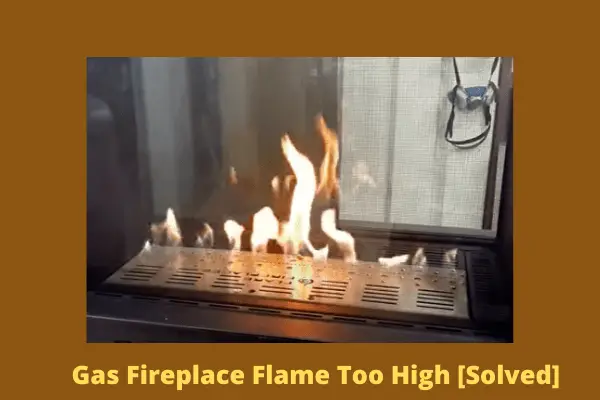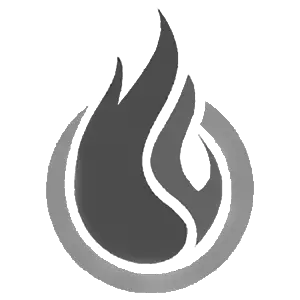When the gas fireplace flame too high issue takes place, it can cause your bills to skyrocket and can also be harming your fireplace’s longevity.
Commonly, the reasons behind a large flame can be improper control knob setting, high gas pressure, defective gas valves, the air shutter being open too wide, and the wrong burner type.

Follow our troubleshooting guide to fix your fireplace flame ASAP.
Table of Contents
- Gas Fireplace Flame Too High [4 Easy Solutions]
- 1. Improper Control Knob Setting
- 2. High Gas Pressure
- 3. Defective Gas Valves
- 4. Air Stutter Open Too Wide
- 5. Wrong Burner Type
- Additional Tips To Maintain Good Flame Height
- FAQs:
- Why is my gas flame yellow?
- Why is my fireplace so loud?
- Can you get carbon monoxide poisoning from a pilot light?
- Can low gas pressure cause yellow flame?
- Can a gas valve be adjusted?
- Conclusion
Gas Fireplace Flame Too High [4 Easy Solutions]
In this section, we will take a deeper look at the issues that cause gas fireplace flames to be too high. We also provide you with the simplest solutions.
Note: You can also read how to fix the Gas Fireplace flame too low problem.
1. Improper Control Knob Setting
You may have set your fireplace flame to a height that is higher than you want it to be.
Solution:
Here’s how you lower the flame height by adjusting the settings.
- Turn the fireplace off to reset the flame. Find the control knob for the gas supply. Locate the control knob, which is normally black with a tiny pointer and the word “pilot” on it, behind the ceramic logs.
- By setting the control knob to “pilot,” you can ignite the gas logs. To let gas flow to the pilot light, turn the knob towards the left and push it down. Use a match or push down the sparker to start the pilot light.
- Turn off the control knob, then give the flame a minute to burn. As specified on the control knob, turn it to the minimum flame setting.
- Find the “on” switch in front of the fuel logs. To light the burners underneath the gas logs, flip the switch to the “on” position. Watch the logs’ first flame height after ignition.
- To raise the flame height, twist the control knob towards the left. Make gradual, tiny tweaks to change the flame’s height. As the room warms up, watch the flame height. By rotating the control knob in a clockwise direction, you can lower the flame’s height.
Watching the video will be helpful for you.
2. High Gas Pressure
If your gas supply pressure is too high, the flame created at the burners will also be more powerful and rise higher. Every gas fireplace comes with a suggested pressure range for proper operation.
Solution:
Check the gas pressure rating on your fireplace. You should be able to spot it on the sides or back. If not, the user manual will definitely have this information. You need to ensure that the gas pressure is within this prescribed range. Here’s how.
- Start by taking the manifold pressure reading. Before beginning, make sure that the fireplace and shut-off valves are not connected to the main gas supply.
- You’ll notice that there are two lines: one entering the gas control and the other exiting it. On the inlet and outlet sides of the gas control, there is a 1/8th inch (3 mm) N.P.T. plug that can be used to attach a test gauge to check the manifold pressure. You need to crack open the tap’s center screw to insert a rubber hose for pressure reading.
- Contact the local gas company when the reading is off. They will fix it.
3. Defective Gas Valves
Defective gas valves can result in too much gas being released at once which makes your gas fireplace flame too high.
Solution:
Access your gas valves at the fireplace burner. In case they appear to be cracked, corroded, or damaged in any way, you need to get them replaced.
Search for replacement parts online or contact your fireplace manufacturer to learn which valve you need to get. Watch this video for assistance on how to replace gas valves.
4. Air Stutter Open Too Wide
Aur shutter controls the air-to-fuel ratio of your fireplace. If the air is too much, the flame will be high. So in case, if your air shutter is open too wide, your heater flame will be too high.
Solution:
Opening your air shutters moderately usually works most of the time. But you can experiment by opening your air shutter wider to see if that is producing a bluer, healthier flame.
Reducing the gap will decrease the amount of air your fireplace flame gets. This in turn should reduce the flame size. So, based on your need, adjust the air shutters accordingly.
5. Wrong Burner Type
Based on the type of gas your fireplace burns, the appropriate burner model should be selected. Natural gas burner models operate differently than LPG models.
Solution:
Check the model of the burner your fireplace is fitted with and whether it is compatible with your fuel type. Buy a new model if necessary.
Additional Tips To Maintain Good Flame Height
When you are operating a gas fireplace, there are a few things you need to keep in check to get a good healthy flame.
How does a healthy flame look? The best gas fireplace flame color is blue. When carbon has a chance to completely combust, only then will your flame look blue in color.
If you can still spot red or yellow at the base of the flame, that is okay. However, a completely yellow flame can be dangerous and produce Carbon Monoxide.
Follow the tips below and your gas fireplace’s uneven flame should be fixed.
i). Clean Your Air Intake Vents And Filter Often
Clean the air filter first. For safety’s sake, shut down the fireplace. Find the air filter, then take it out. It may simply be slid out. Typically, removing air filters doesn’t require the use of any tools.
Now take the air filter outdoors and give it a good rinsing with a garden hose or just wash it under a faucet. To properly clean it, scrub it with a brush. Dry it out.
Next, make sure the vents’ interiors are spotless. To access the vent, use wire brushes. Reinstall the air filter once it has been verified to be clean.
ii). Clean Your Chimney After Every Heating Season
Having to clean the chimney is a difficult task and involves a number of tools. Do the following.
- To prevent dirt from entering your home, close the glass door to your fireplace and the wood stove. Obtain a flue brush that happens to fit your chimney and attach fiberglass rods long enough to pass through your chimney to the brush.
- Removing the chimney cap You must remove a few screws.
- Incorporate the brush into your chimney. To remove all of the grime and creosote, scrub ferociously.
- Use a shop vac to remove all the creosote dust and leftover ashes from the woodstove.
iii). Clean Burner Orifice
It is also important that you keep the burners clean. A wire brush and a small can of compressed air should be enough to give your burners a thorough cleaning.
You need to access the burners by removing them from their mounting. Carefully clean the burner orifice with a wire brush. Blow out any loose debris with a can of compressed air.
FAQs:
Why is my gas flame yellow?
A yellow flame on the burner indicates that the gas is not being completely burned by the burner because it is not receiving enough air. You can solve this issue by changing the burner’s air shutter so that it admits more air.
Why is my fireplace so loud?
If the pilot light makes a roaring noise when it is on, the flame probably needs to be adjusted. A fan or blower is typically the source of a grinding or shrill noise.
Can you get carbon monoxide poisoning from a pilot light?
Yes. Carbon monoxide, an odorless, colorless gas that can flood your home and result in carbon monoxide poisoning, can be produced by a yellow or orange pilot light. Dizziness, headaches, weariness, nausea, loss of consciousness, brain injury, and death are all signs of this illness.
Can low gas pressure cause yellow flame?
Yes. In fact, low gas pressure is frequently what causes a yellow flame. We have instructions on how to check the gas pressure above. Hopefully, that will help you get a pressure reading.
Can a gas valve be adjusted?
Yes. To increase pressure, you turn it clockwise and in the opposite direction to reduce pressure. Stay within the pressure range given by the manufacturer.
Conclusion
Hopefully, your issue with the gas fireplace flame being too high is fixed after following our instructions. While attempting any repairs on your fireplace, we don’t recommend you do it yourself unless you are feeling confident about your mechanical, and electrical knowledge.
A fireplace is one of the most expensive home appliances and it is always better to err on the side of caution.

